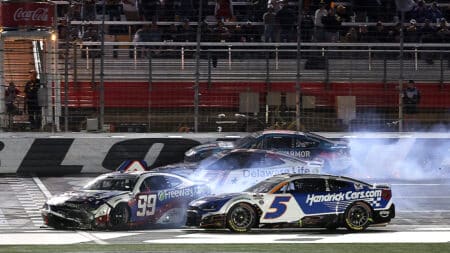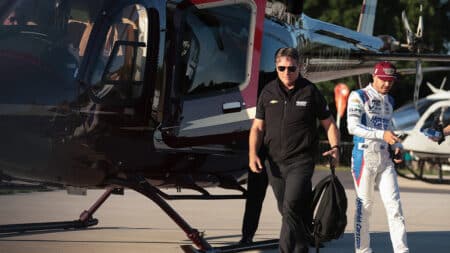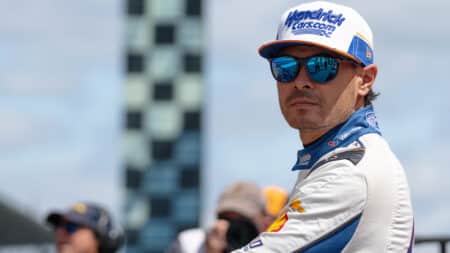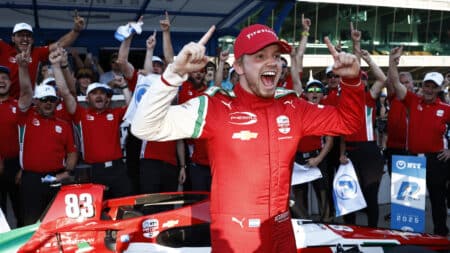
'Double isn't worth it', says Larson after 2025 attempt ends in disaster
Two crashes left Kyle Larson's hopes of completing the Indy 500 and Coca Cola 600 double in tatters — but did he even stand a chance in the first place?
A series taken from the 164-page Motor Sport special Great Racing Cars, which is available to buy here
From the editor Damien Smith
How would you define a ‘great’ racing car? Race wins and championship titles are an obvious place to start – and admittedly, when we began the process of rounding up the ‘voices’ to fill this special magazine, published by the team behind Motor Sport, we had in mind the likes of the Lotus 72, Ferrari F2004, Porsche 917, Audi R10 and so on.
But as the interviews of familiar racing figures began, we realised greatness is often a very personal thing. Naturally, most – but not all – would pick cars they had experienced first-hand, as a driver, designer, engineer or team boss. And on occasion the cars that stood out in their minds as ‘great’ weren’t necessarily so in the grand scheme of history. That’s why you’ll find a Minardi here among Formula 1 cars from Lotus, Williams and McLaren.
Unexpected? Certainly. Wrong? Not to the man who chose it.
As the interviews accumulated, our magazine took on a life of its own, full of personal anecdotes about the myriad cars that made careers. Some of those we spoke to, such as Mario Andretti and Dan Gurney, couldn’t be tied to a single choice from multi-faceted lives at the wheel. Such heroes have earned the right to choose an F1, sports and Indycar, so we allowed them more than one bite.
Others refused to be confined by category. Hence the short ‘Odd ’n Sods’ chapter on cars that, by and large, are mere footnotes in lower divisions of racing lore.
Thus there is nothing definitive about the selection listed herein. Then again, there’s no claim that this compilation offers the ‘Greatest Racing Cars’ of history. It’s much more personal than that, much more quirky – and all the better for it.
Dan Gurney
All-American hero in F1, Indycars, sports cars… anything and everything!
My favourite car of all our Eagles was our 1981 Eagle-Chevy ‘Boundary Layer Adhesion Technology’ car. Mike Mosley scored a fantastic win in that at Milwaukee, coming through the field from the back of the grid after blowing an engine in qualifying.
It was a superb performance and I loved that car because it was a concept that was completely different from anything else out there at the time. It was even better than we thought it was going to be, but we really didn’t know why. It was off the charts and so good and so different that it was banned by the powers that be!
Like a BLAT out of hell
Gordon Kirby recalls how and why Gurney’s BLAT Eagle was so special

It’s probably happened before and since, but the most spectacular last to first performance I’ve ever witnessed took place on the Milwaukee Mile in June 1981, when Mike Mosley drove All American Racers’ unique Eagle-Chevy from the back of the grid to win.
Mosley performed his feat aboard what was known as the Boundary Layer Adhesion Technology (BLAT) Eagle-Chevy first raced by AAR in 1980. The car is Dan Gurney’s favourite Eagle Indycar because it’s the definition of All American Racers. It was completely different from conventional thinking, highly innovative in a number of ways, and – the ultimate compliment – it was so successful that it was banned.
Most CART teams ran turbocharged Cosworth DFX V8s in those days, but AAR typically went a different route developing its own normally-aspirated Chevrolet stock-block engines built around Donovan aluminium blocks. The Eagle chassis was completely unlike the other top cars of the time from Penske, Chaparral, Coyote, March, Wildcat and Phoenix. Everyone else was in the midst of developing classic, ground-effect cars based on the Lotus 79 concept with underwings or ‘tunnels’ creating a low pressure area under the car.
But AAR found a different method. Using the BLAT technique, Dan and engineers John Ward and Trevor Harris produced a car that was at least as – and maybe more – effective than traditional ground-effect cars.
Compared with its competitors the Eagle presented a very different nose to the wind and also had a strikingly different overall shape.
Instead of ducting air underneath the car into an enclosed venturi or underwing in the usual ground-effect way, the BLAT concept involved a twin vortex generating shape that was linked to the trailing edge of the rear bodywork, wing and a very efficient cooling system exhaust. The routing of the exhaust system added further energy and downforce to the airflow, and variants of this concept have been used more recently in Formula 1.
Sure enough, the maverick Eagle-Chevy package was entirely competitive with the turbo Cosworth-powered opposition in 1981. Dan had also sold Pepsi-Cola on sponsoring the team and after five or six tough years things were looking good for a fresh start from AAR. At Indianapolis Mosley and the Eagle were quick from the start of practice and attracted plenty of attention from the other teams, who started complaining about the car’s legality.
Mosley qualified second for the 500, sharing the front row with Bobby Unser’s Penske-Cosworth and AJ Foyt’s Coyote-Cosworth, but he was the race’s first retirement after just 16 laps with an oil leak. At Milwaukee the following week there was more bad luck when Mosley started last after missing qualifying because of an engine failure. He had to start from the back of the field, 25th, but as soon as the green flag waved he began to motor to the front. Incredibly, he passed everyone and went on to win as he pleased by over a lap from Kevin Cogan and Mario Andretti.
Taken from the Motor Sport website

Two crashes left Kyle Larson's hopes of completing the Indy 500 and Coca Cola 600 double in tatters — but did he even stand a chance in the first place?

The crunch point of Kyle Larson's Indy 500 and Coca Cola 600 double bid will come as he races from Indianapolis to Charlotte in a complex procedure involving cars, helicopters and planes. Ryan Glenn will be co-ordinating it... by text message

Kyle Larson will once again attempt the double this weekend. He explains his plans to complete the Indy 500 and NASCAR's Coca-Cola 600 in one day and overcome the "PTSD" of last year's bid

Robert Shwartzman and Prema stunned the field by claiming pole position for the 2025 Indianapolis 500 in his first-ever oval race. Here's a look at how they pulled it off